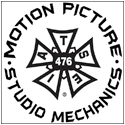
Late Friday, we reported that California Gov. Gavin Newsom and the California Department of Public Health stated that film and TV production can resume in the state beginning June 12. Large scale production in California has been largely shut down since the middle of March.
Earlier in the week, the Alliance of Motion Picture and Television Producers outlined in a white paper recommendations on reopening production to Newsom and to New York Gov. Andrew Cuomo and to the Los Angeles Department of Public Health.
Reel 360 has obtained this report and we will be looking at highlights all week.
Among the recommendations in the white paper were plans on addressing “set hygiene, disinfection and maintenance, catering, mandatory employment of COVID-19 Compliance Officer(s), symptom screening, physical distancing, paid leave policies and Covid-19 training, among other critically important topics necessary for the safe resumption of production.”
“The health and safety of the general public and all cast and crew is the highest priority. Re-opening the industry and returning to work are also significant and important priorities,” the report begins.
It adds, “Infection prevention measures will be developed and applied, including physical distancing at all times when possible, enhanced sanitation (high-touch wipedown, disinfection of equipment), and hand hygiene (increased access to hand washing stations, alcohol-based hand sanitizer).”
The AMTMP also recommends that, “One or more autonomous COVID-19 Compliance Officer(s) with specialized training, responsibility and authority for COVID-19 safety compliance and enforcement will be in the workplace to address issues as they arise.”
Thorough training on principles of infection prevention, PPE, physical distancing and signs/symptoms of COVID-19 will be provided to all, with role-specific additional training as needed.
The judgment of Department Heads and their crews, in collaboration with Unit Production guidelines will be followed.
To the extent possible, physical distancing shall be maintained. When physical distancing is impracticable, other risk mitigating measures shall be taken.
The report also outlines:
Regular, periodic testing of cast and crew for COVID-19 is critical for a safe return to work.
- Universal symptom monitoring, including temperature screening, may be used to further mitigate risk.
- Appropriate and adequate PPE will be provided to cast and crew by the employer as necessary. Disposable masks will be replaced each day and reusable masks will be cleaned each day.
- Medical expertise must always guide decision making with respect to testing, contact tracing, symptom screening and similar
Managers (UPMs) and Assistant Directors (ADs), will be considered when structural and logistical changes are made to accommodate the new working practices. Individual rights under applicable laws intended to protect against discrimination must be respected and safeguarded
to support the maintenance of a non-discriminatory workplace.
Adequate staffing and space for physical distancing is essential for an effective health and safety plan.
ALSO READ: California film production can resume June 12
Resuming production during this time may be highly stressful and cause anxiety. The implementation of mental health resources to support the wellness of those participating in a production may be necessary. Options could include:
- Emotional support hotline
- Telemedical health and behavioral health resources
- Mindfulness training; and provision of online tools and resources.
- Paid leave policies shall be flexible and non-punitive to allow sick and quarantined employees to stay away from co-workers and the general public. These paid leave policies will be implemented to encourage compliance with infection prevention guidelines.
The National Institute for Occupational Safety and Health’s (NIOSH) Hierarchy of Control will guide approaches to mitigate risk:
- Systems will be employed to assess health/wellness of all personnel prior to entry onto set.
- Engineering and administrative controls will be developed and emphasized whenever feasible.
- When engineering and administrative controls are not feasible, personal protective equipment (PPE) will be used.
Cast and crew are encouraged to report problems, ask questions and suggest solutions to enhance the safety and productivity of the workspaces.
The CDC advises that those over age 65 and those with co-morbidities consult with their healthcare providers regarding the risks of COVID-19.
Given the dynamic and evolving nature of the COVID-19 pandemic, these interim guidelines will likely need to be modified and adapted as circumstances change.
Meetings
Use phones, videoconferencing or similar technologies for meetings whenever possible. Avoid people gathering around a computer to watch together. Consider virtual production meetings whenever feasible.
Writers’ Rooms
Whenever possible, move to virtual writers’ rooms.
When virtual writers’ rooms are not possible, maintain 6 feet of distance, use face coverings, and perform hand hygiene before and after the meeting. Minimize use of paper.
Video Village
Use technology options such as additional monitors and remote viewing with the prior approval of or consultation with the Director, when required and as applicable, to allow the viewing of video from a separate location to facilitate physical distancing.
Audiences
At this time, the use of live audiences is discouraged. On a case-by-case basis, live audiences may be used as long as audience members:
• Wear face coverings at all times
• Maintain 6 feet of physical distance, including while waiting in line and sitting in a studio; and
• Undergo symptom screening on entry.
An appropriate physical separation shall be maintained at all times between performers working without PPE and audience members. Medical professionals shall be consulted to determine the nature of the physical separation required for the safety of the performer in such situations, including additional physical distance or physical barriers (e.g., plexiglass walls).
The Unions, Guilds and Employers have acknowledged the need to develop department- specific operational protocols and project-specific workflows, which will be subject to further discussion and agreement between the Employers and the respective Unions and Guilds representing the cast and crew.
All have agreed to develop those protocols and workflows separately once government authorizes production to resume.
SOURCE: AMPTP









